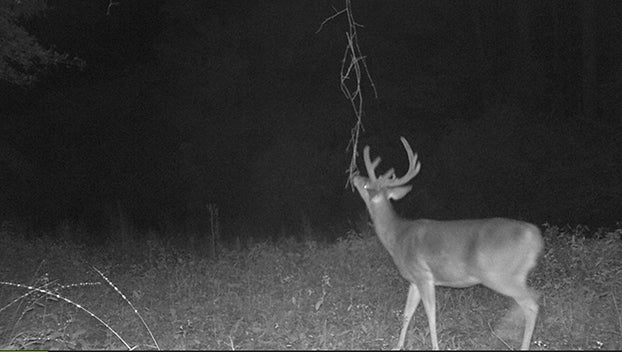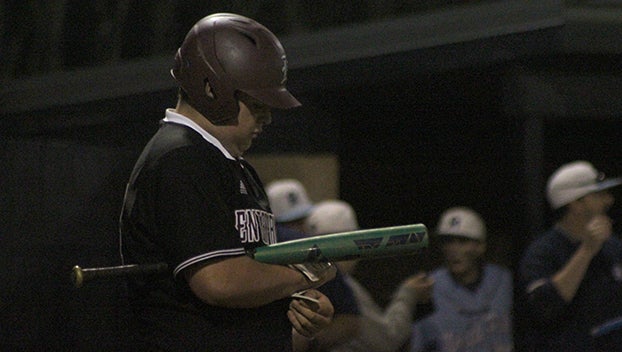Mississippi State leading Chronic Wasting Disease research
Published 8:00 am Wednesday, March 6, 2024

- A buck checks out a licking branch on a line of scrapes along the edge of a food plot in Lincoln County. Mississippi State’s Deer Lab found they could detect CWD prions in samples taken from scrapes in North Mississippi at the heart of the CWD hot zone and later found prions accumulated on feeders (Hunter Cloud’s Trail Cam | The Daily Leader)
STARKVILLE — Mississippi State University is leading the way in researching Chronic Wasting Disease. The MSU Deer Lab is working to answer questions to help state agencies like the Mississippi Department of Wildlife, Fisheries and Parks to better understand management of CWD.
MDWFP Commissioners opened the door to discussing a statewide ban of supplemental feeding for the purpose of disease management in February. Commissioners asked in the February meeting if feed bans did mitigate the disease. MSU’s research backs up existing disease management strategies for density dependent disease like CWD with science.
A ban of supplemental feeding and feeders are a part of best management practices when working to manage Chronic Wasting Disease. Biologists and state wildlife agencies recognized the danger of unnatural congregations of deer around feeders could allow for CWD to be more likely to spread as it is density dependent. Public backlash with new CWD zones is usually directed at the ban of supplemental feeding.
CWD is a 100 percent always fatal infectious prion disease found in deer and other members of the cervidae family. At this time, there are no cures or vaccines for the disease and the risk of CWD evolving to have zoonotic spread is a concern.
Research at Mississippi State University shows the feeders could in fact play a role in environmental detection and contamination. Steve Demarais, Co-Director of MSU Deer Lab, presented a paper at the Southeastern Deer Study Group answering questions about feeders being a CWD management concern.
The project was a followup to research looking at the presence of CWD prions in scrapes. MSU Deer Lab initially set out to learn where CWD could be detected on the landscape and inform state wildlife agencies on where the disease is.
MDWFP currently relies on hunter submitted samples to detect Chronic Wasting Disease. The problem is some hunters in some areas may be biased against submitting samples because they do not want to know they have CWD.
“We wanted to come up with an environmental sampling method to more efficiently locate where the disease was located,” Demarais said. “If we could find CWD on the landscape we can find where it is quicker.”
The idea for the environmental sampling project came in the wake of COVID-19 when agencies were looking for the disease in areas rather than individuals. MSU used the scrape project to make sure the sampling worked in an area where the disease was known to be. CWD Prions were found in scrapes, in soils and on licking branches.
Last year, MSU looked at how they could detect the disease outside of known positives with scrapes. The “Canary in a coal mine,” showed Claiborne County had CWD prions in the landscape. Prions are shed by infected deer. Mississippi later detected a positive in Claiborne County about two miles away from the positive scrape, Demarais said.
North Carolina used the soil test to look for CWD with a new outbreak there. Out of 35 scrapes, CWD prions were found in half of them and up to 10 miles away from known positive detections. In Mississippi, soil tests have detected CWD prions 19 miles away from the nearest positive in Issaquena County, Demarais said.
“It really can be an effective early warning signal for the presence of CWD in the environment but not a regulatory testing device,” he said. “It can help agencies say ‘Hey we haven’t had a positive detection but it is here and we need to sample more intensively.’”
Feeders project
In the latest research project, MSU maintained 12 gravity feeders from September 2022 to March 2023 in northern Mississippi CWD zones where prevalence is around 30 percent. Demarais said they received a special permit from MDWFP to conduct the research to detect if prions would in fact accumulate on the feeders.
In MSU’s project, six feeders were set up with no exclusion, meaning deer could feed with no trouble, three feeders were set up for exclusion of deer, accomplished through fencing with holes cut at the ground level to permit raccoons to enter, and three environmental control feeders were fully fenced off and not filled with feed as the experiment control.
Demarais said one caveat to their research is the deer activity in northern Benton County is low. Deer observations by hunters are down and browse surveys showed an abundance of high quality forage for deer. He hoped deer would actually show up to the study area with the abundance of food on the landscape.
Researchers swabbed the feeder’s spouts at set up and four times with each swab around six weeks apart. Swabs were tested using the RT-QuIC test to detect the presence of Chronic Wasting Disease Prions. All deer and raccoon feeders showed statistically significant prion detection by four months post set up thus proving prions do accumulate on feeders.
Demarais said the data actually showed four of the six non-exclusionary feeders had CWD prions within the first six weeks. A surprising result found by MSU was the presence of prions on the feeders only raccoons could reach.
Demarais said the research team collected 10 raccoons from the area and sent them to the University of Minnesota to conduct necropsies on the raccoons. Four of the 10 racoons had CWD prions detected on their feet but none of them had CWD in their lymph nodes or central nervous system. Demarais concluded raccoons were physically carrying around prions as fomites.
“With the disease agent present it suggests the feeders are accumulating the agent and it is one of the reasons feeding should be disallowed,” Demarais said. “Our other issue we worry about is how it concentrates deer.”
Relative disease risk
MSU looked at the relative risk of deer coming in contact with disease at feeders, food plots and natural mast trees. Demarais said they set up cameras and looked at the visitation rate of an area of 24 square yards.
Weekly visitation rate by white tailed deer was greater at deer feeders than food plots and mast trees. Deer visited feeders a median of 24.5 times per week while they visited food plots a median of 12.7 times per week and mast trees had a median of two times per week. It could be concluded deer have a greater chance of spreading the disease when they frequent a specific location such as a feeder more.
Demarais said they looked at the contact rate or physical touching of deer in those areas. Individual deer touched other deer more often at deer feeders than food plots and mast trees. The median for deer touching others at feeders was 4.1 times per week while food plots had a median of 0.1 and mast had a median of 0. For context, Benton County has oak trees everywhere but the mast tree information serves as a data point moving forward.
“We are trying to further refine the scope and uses of this early sentinel on the landscape. We want to answer how far out can we find the disease and how early can we find it,” Demarais said. “If you can catch it at stage one you have better management options if you find it early.”
MSU’s Miranda Huang has worked on projects in the past looking at ticks and other disease risks associated with supplemental feeding including parasites and aflatoxins.





